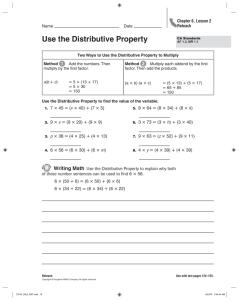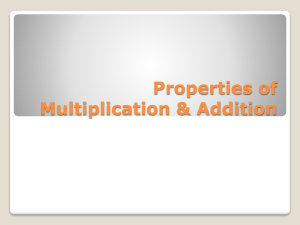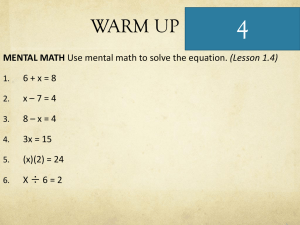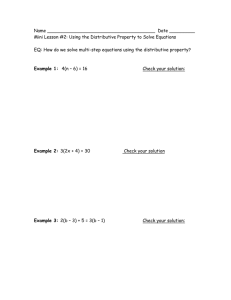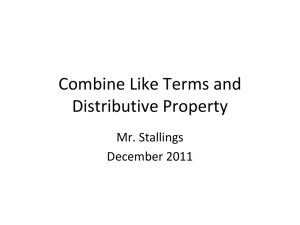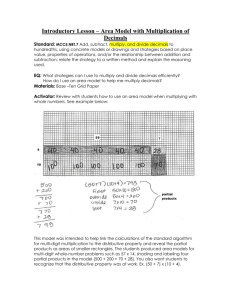Multiply Using the Distributive Property
advertisement
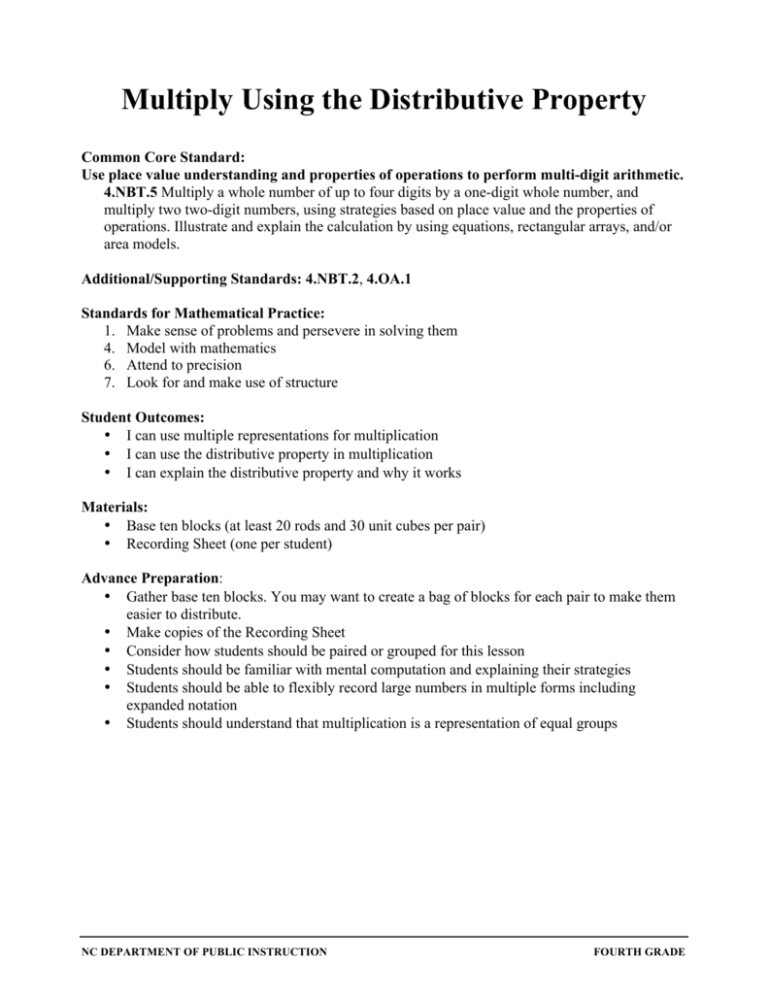
Multiply Using the Distributive Property Common Core Standard: Use place value understanding and properties of operations to perform multi-digit arithmetic. 4.NBT.5 Multiply a whole number of up to four digits by a one-digit whole number, and multiply two two-digit numbers, using strategies based on place value and the properties of operations. Illustrate and explain the calculation by using equations, rectangular arrays, and/or area models. Additional/Supporting Standards: 4.NBT.2, 4.OA.1 Standards for Mathematical Practice: 1. Make sense of problems and persevere in solving them 4. Model with mathematics 6. Attend to precision 7. Look for and make use of structure Student Outcomes: • I can use multiple representations for multiplication • I can use the distributive property in multiplication • I can explain the distributive property and why it works Materials: • Base ten blocks (at least 20 rods and 30 unit cubes per pair) • Recording Sheet (one per student) Advance Preparation: • Gather base ten blocks. You may want to create a bag of blocks for each pair to make them easier to distribute. • Make copies of the Recording Sheet • Consider how students should be paired or grouped for this lesson • Students should be familiar with mental computation and explaining their strategies • Students should be able to flexibly record large numbers in multiple forms including expanded notation • Students should understand that multiplication is a representation of equal groups NC DEPARTMENT OF PUBLIC INSTRUCTION FOURTH GRADE Directions: 1. Begin the lesson by writing 6 x 32 for all the students to see. Ask the students to compute 6 × 32 mentally without paper, pencil, or calculators. Ask volunteers to share different methods of mental computation for this problem, and record their methods on the board. Spotlight any method that uses the distributive property: Example of a response that uses the distributive property: 6 x 32 6 x 30 = 180 and 6 x 2 = 12 180 + 12 = 192 Point out how the number 32 was broken into 30 + 2. This makes it easier to multiply and add mentally. Thus, this problem could be written as follows: 6 x 32 = (6 x 30) + (6 x 2) 2. Using base ten materials (such as blocks), students should model 6 x 32. This task should be completed independently or with a neighbor by showing 6 groups of 32 as shown below: 3. Using the base ten blocks, guide students to observe that they have 6 groups of 30 and 6 groups of 2. Ask the students, “How would these groups look in a number expression?” Help students make a connection between the blocks and the expression (6 x 30) + (6 x 2) 4. Have students record their drawings and solution in symbols on their Recording Sheets. 5. Present students with another problem 4 × 53 by recording it on the board. Ask the students to model this problem with base ten blocks. Have them draw their diagram on the Recording Sheet. Then work with a partner to show this problem using numbers and symbols. Students should take turns explaining the mathematics they are using and why it makes sense. Once all have explained the problem to their partners, write the steps on the board. 6. When most pairs have finished, ask students to share their thinking about the mathematics they are using. Based on student explanations, introduce the term “Distributive Property.” Ask student to explain how the distributive property is related to expanded notation. As students share their thinking record any method that makes this connection such as: 53 = 50 + 3 So 4 x 53 = (4 x 50) + (4 x 3) 7. Once again, present a third problem such as 3 x 67 by writing it on the board. Ask students to solve the problem by grouping their blocks. They should use the same process of modeling the problem with blocks and recording their work on the Recording Sheet. This time, challenge students to use the term “distributive property” as they explain the mathematics they used with their partners. NC DEPARTMENT OF PUBLIC INSTRUCTION FOURTH GRADE 8. When most pairs have finished, ask students to share the mathematics they used with the whole class. Challenge them to use the term “distributive property” as they explain their reasoning. 9. Finally students will apply their understanding in the context of a word problem such as: A candy company has orders for chocolate bars from 5 different stores. Each order contains 45 chocolate bars. Use the distributive property to figure out how many chocolate bars the candy company needs to make. Students should solve this problem using the same process: modeling with blocks, recording on the Recording Sheet, and discussing their reasoning with a partner. 10. Once most pairs have completed the task, close the lesson by asking students to explain how using the distributive property can help you solve multiplication problems. This question might prompt a small group or whole-class discussion or it might be used as a journal prompt. Questions to Pose: As students work with their partner: • How does your model/drawing connect to the numbers and symbols? • Why does it make sense to use an addition symbol in the expression? • How does breaking the number apart help you solve the problem? • How did you decide where to start solving this problem? During class discussion: • Explain how the distributive property is helpful when you are multiplying large numbers. Create a multiplication problem that supports your explanation. • What would happen if you tried to use the distributive property to solve a problem such as 458 x 7? • How does the distributive property connect to the models we have been using? Possible Misconceptions/Suggestions: Possible Misconceptions Students have difficulty decomposing numbers using place value. They have trouble recognizing that 32 is the same as 30 + 2. Students do not connect multiplication with equal groups. NC DEPARTMENT OF PUBLIC INSTRUCTION Suggestions Give students the opportunity to build two-digit numbers with a variety of manipulatives. Emphasize the values of tens and ones. Provide a variety of manipulatives for students to partition into equal groups. Encourage students to provide stories that match their manipulatives such as “Four squirrels each carried 8 acorns.” Help students write a multiplication expression that corresponds with their manipulatives and context. FOURTH GRADE Special Notes: Follow up lessons could • Extend to multiplying with larger numbers including three digits by one digit and four digits by one digit • Vary the problem type based on Table 2 “Common Multiplication and Division Situations.” This table is found on page 89 of the Common Core State Standards for Mathematics Glossary. http://www.corestandards.org/assets/CCSSI_Math%20Standards.pdf • This lesson applies the distributive property to decomposing large numbers (32 = 30+2). Provide problems that model and apply the distributive property in reverse such as 4 x (8 + 5) • Explore whether or not the distributive property could be used in addition, subtraction, and division Solutions: NA Adapted from “Exploring the Distributive Property” Mathematics Enhanced Scope and Sequence. Virginia Department of Education, 2011. NC DEPARTMENT OF PUBLIC INSTRUCTION FOURTH GRADE Multiply Using the Distributive Property Recording Sheet Name (Use Date Pictures for tens and for ones.) Numbers and Symbols 6×32=(__×__) + (__×__) Adapted from “Exploring the Distributive Property” Mathematics Enhanced Scope and Sequence. Virginia Department of Education, 2011. NC DEPARTMENT OF PUBLIC INSTRUCTION FOURTH GRADE
